This is an AGFA Flexilette, a 35mm twin lens reflex camera produced by AGFA Camera-Werk Muenchen starting in 1960. The Flexilette was also called the AGFA Reflex in other markets and is part of the Optima line of 35mm cameras produced from the late 1950s through the mid 60s. The Flexilette is one of only a few 35mm TLRs offering all of the same features of a larger medium format TLR, but in a more compact body. Like other TLRs, the image seen in the viewfinder comes from light entering the top lens and reflected back up to the waist level finder. Images are exposed through the bottom lens onto regular 35mm film. The Flexilette was a short lived model as there never was much of a market for 35mm TLRs, but for those looking for something different, it definitely fits the bill.
Film Type: 135 (35mm)
Lens: 45mm f/2.8 AGFA Color coated 3-elements
Focus: 0.9 meters to Infinity
Viewfinder: Waist Level Coupled Reflex Viewfinder
Shutter: Prontor Leaf
Speeds: B, 1 – 1/500 seconds
Exposure Meter: None
Battery: None
Flash Mount: PC Port M and X Flash Sync
Weight: 754 grams
Manual: https://www.cameramanuals.org/agfa_ansco/agfa_flexilette.pdf
How these ratings work |
The AGFA Flexilette is a very cool, but completely unnecessary camera that was produced for a very short period of time. As one of the very few 35mm TLRs ever made, its use is different from most cameras and can be a lot of fun, even though the camera has some pretty significant ergonomic flaws. A combination of very quiet operation and a waist level finder means this would be an ideal camera for discreet photography. Despite all of that however, the images you’ll get from the Apotar lens are stunning. If you like strange and unusual cameras, this one is definitely one you should consider. | ||||||
| Images | Handling | Features | Viewfinder | Feel & Beauty | History | Age | |
| 2 | 1 | 1 | 1 | 2 | 1 | 20% | |
| Bonus | +1 for uniqueness as one of a very few number of 35mm TLRs | ||||||
| Final Score | 10.6 | ||||||
With the soaring success of the Leitz Leica and post war Zeiss-Ikon Contax, the West German camera industry after World War II was heavily rooted in rangefinder cameras. In the 1950s when the rest of the world started to take notice of single lens reflex cameras, with the exception of the Wirgin Edixa, West Germany was lacking options in this segment.
By the time West German SLRs did start to hit the market in the early 1960s, nearly all of them used leaf shutters. AGFA, Kodak AG, Voigtländer, and Zeiss-Ikon all released their own lineup of single lens reflex cameras with Compur or Prontor leaf shutters.
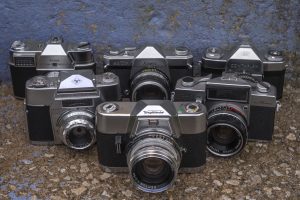
Besides the Wirgin, the only other West German 35mm SLR available in 1960 was the extremely expensive Zeiss-Ikon Contarex. Where were the lower cost alternatives like the Praktica, Pentax, or the Zenit?
I attempted to find an answer to this question by asking several other camera historians that I trust. From Jim Lager, Wes Loder, and Cheyenne Morrison, the most common theme in their responses was that the Germans were stubborn and resisted change.
Some additional factors were that both Leitz and Zeiss were leaders of the industry and both were heavily invested in their rangefinders. Leitz owned the patents on their own focal plane shutter and probably didn’t want to license it to other companies. Although the Zeiss-Ikon Contax had a focal plane shutter too, it was a proprietary design from before the war that would not have worked in an SLR.
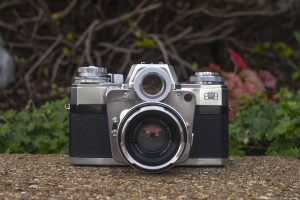
For the Contarex, Zeiss created an all new shutter that was overly complex and was not something they wanted to license out to other companies or build themselves in a lower cost model. Leitz would eventually release the Leicaflex SLR in 1964 with a focal plane shutter, but development on this camera was slow as the company wasn’t in a hurry to compete with its own rangefinder sales.
In regards to why so many eventual West German SLRs had leaf shutters, a contributing factor likely was that Zeiss owned a controlling interest in both Deckel and Gauthier who produced the Compur and Prontor shutters and it was simply more cost effective to use them, rather than build an all new focal plane shutter from scratch. Zeiss had been profiting on the sale of all folding and solid bodied leaf shutter cameras and likely didn’t want the money train to end by encouraging further development of new focal plane shutters.
Is there another, more specific reason for why West German optics companies showed so little interest in SLRs? Perhaps, but a combination of the factors above, along with the general opinion of stubbornness likely explains it.
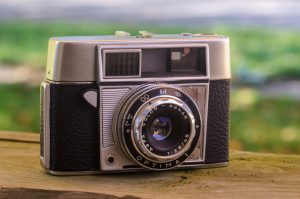
As for AGFA, like most other West German camera makers, they had a long and successful line of Compur and Prontor leaf shutter scale focus and rangefinder cameras. From the original Karats to their highly successful Optima series, I am not aware of any focal plane AGFA cameras produced in the 1950s or earlier, so when it came time to develop the company’s first SLR in 1958, they went with a leaf shutter design like almost everyone else.
The AGFAflex series used a body that strongly resembled their Optima rangefinder and likely was chosen to keep a similar look among the company’s family of cameras. Models were produced with both waist level and eye level viewfinders. Some had fixed lenses and in the case of the Ambiflex, others had an interchangeable lens mount.
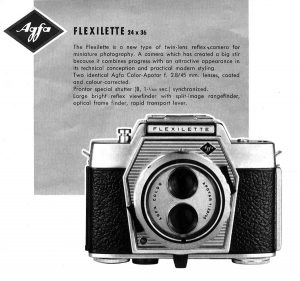
Shortly after the release of the AGFAflex, AGFA released a twin lens version called the Flexilette. Although commonly referred to as a TLR and meeting all the criteria of other TLRs, to me, I think a better description of it is as a twin lens SLR as the camera essentially is an SLR with a second lens for the viewfinder.
Despite its odd appearance, the Flexilette had a few advantages over the AGFAFlex. For starters, leaf shutter SLRs are more complex than focal plane SLRs as the leaf shutter has to open and close twice for every exposure. When composing your image, the shutter needs to remain open to allow light to pass through the viewfinder while a capping plate drops down behind it to prevent unwanted light from exposing the film at the film plane. Then the shutter closes while the capping plate flips out of the way in anticipation of the exposure being made. Finally the shutter opens and closes once again to expose the image, and finally the capping plate drops back down in anticipation of opening the viewfinder again.
With the Flexilette, the shutter doesn’t need to do any of this extra work. Since the taking lens has nothing to do with the viewfinder, the shutter only needs to open and close at the moment of exposure just like a leaf shutter on a rangefinder camera. There also is no need for a capping plate, or any extra parts needed to protect the film from unwanted exposure.
Another advantage addresses one of the primary early complaints of SLRs in general, which is that the viewfinder is blacked out at the moment of exposure. With most SLRs, a reflex mirror needs to flip up, blocking light from the viewfinder at the moment of exposure, causing the viewfinder to go dark. On early SLRs, the viewfinder stayed dark after an exposure, only to drop down again when the shutter was cocked later. Starting with the Asahiflex IIa, instant return mirrors minimized this viewfinder blackout to only the exact moment of exposure, but dropped the mirror back down again immediately after the exposure was made. With the Flexilette, there is never any viewfinder blackout since the light entering the viewfinder comes from a completely separate lens from the one that makes the exposure.
Also since the main reflex mirror never needs to move, it makes for a much quieter shooting experience. If you had to choose between the Flexilette and AGFAflex in a situation where you needed to shoot discreetly, the Flexilette would be a much better option.
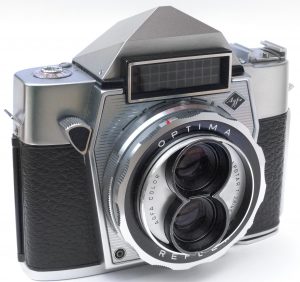
Of course, there’s still the issue of parallax on closeups like all TLRs have, and the unique design of the twin lenses means that interchangeable lenses were not possible. The Flexilette only came with a waist level finder, but in 1961 a new model called the Optima Reflex would replace it with both a pentaprism viewfinder and also automatic exposure, but would lose full manual operation.
The Flexilette was only produced for a very short amount of time, and I found no evidence of it being exported to the United States as none of my usual resources show a catalog listing or advertisement for it. The presence of an English language manual for the camera however, suggests that it was sold in other English speaking countries.
The only reference to what the camera might have sold for comes from a German language brochure that I’ve included below which said the camera sold in 1960 for DM 199. A similar brochure from the same year for the AGFA Colorflex with f/2.8 Color-Apotar lens and waist level finder shows a price of DM 298 which suggests the Flexilette sold for 1/3rd less than a comparable AGFA SLR.
Using this information, looking at US prices of similar AGFA SLRs from the same time period, this April 1960 ad for the AGFAFlex with f/2.8 Color-Apotar lens shows a retail price of $159, which if the Flexilette would have sold for 1/3rd less, suggests an approximate US retail price of $106.50. Whether or not the Flexilette would have actually sold for that is anyone’s best guess, but it is probably not that far off.
The Flexilette is one of only a very small number of 35mm TLRs. Other examples include the original Zeiss-Ikon Contaflex, Bolsey C33, Samocaflex 35, and Tessina. Of course there were 35mm adapters for some medium format TLRs like the Rolleiflex and Yashica 635 which allow for 35mm film to be shot in those cameras too.
The fact that so few were made, and of the ones that were, sold for a very short period of time suggests this was a market segment that few people wanted. This makes cameras like the Flexilette as rare as they are interesting, and can sometimes sell for some crazy prices.
Today, collectors generally love strange cameras like these. Their unique looks and quirky operation check all the right boxes for both collectors and users alike. I was fortunate enough to find this camera in good condition for a reasonable price and even before I shot a single frame in it, I knew it would be one I would keep in my permanent collection.
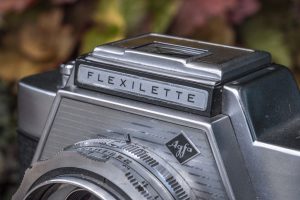
My Thoughts
I’ve had both an AGFA Colorflex and AGFAflex for quite some time in the “review queue”. Neither cameras have yet to make an appearance here as one of the two doesn’t work at all, and the other gave me a roll of less than exciting images that weren’t worth sharing.
I had always figured that at some point I’d come back to those cameras when one day I saw this beautiful Flexilette in a local thrift shop and knew that an AGFA review was in my future.
Like the Colorflex and AGFAflex, the Flexilette was very stiff when I got it. Turning the focus ring was not only difficult, but also painful due to the sharp knurled edges around the ring. Thankfully, the shutter worked, and with some repeated use the focus ring loosened up a bit. The camera was dirty and smelly, but after a good cleaning, seemed good enough to shoot without any required repair.
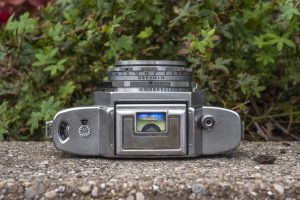
The top plate of the camera is very different from other SLRs as apart from the waist level finder in the middle, the only things you’ll see are the exposure counter and film type indicator on the left, and cable threaded shutter release on the right.

The film type indicator is unusual for a 1960s camera in that it only shows DIN numbers, rather than ASA which would have been increasingly common at the time. Possible choices are 13° through 29° black and white, CN 14° and 17°, and unnumbered indicators for CK and CT. The Flexilette’s user manual has references to these in various AGFA emulsions.
When loading in a new roll of film, the exposure counter must be manually reset using a sliding switch on the back edge of the top plate. Like most other AGFA cameras of the era, it is a subtractive counter, showing how many exposures are left on the roll, rather than how many have been taken which was more common on Japanese cameras.

The bottom of the camera has a pop up rewind knob, 1/4″ tripod socket, and the film advance lever. In the image to the left, the orientation of the camera shows these controls opposite of where they’d be with the camera in your hands. The film advance lever is normally operated by your left hand. Despite looking like the tripod socket is black plastic, it is actually metal which is great for strength, but it is disappointing to see it offset to the side, and not in the center to maintain balance. Also, notice a tiny black foot immediately below the shutter which matches the height of the rest of the bottom of the camera so that the camera can be set on a flat surface without falling over.
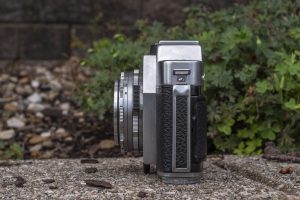
The camera’s left side is where you’ll find the film door release latch. Lift up on it and the door will pop open. Looking at the camera from the side, you get a good look at how narrow the camera is back to front.
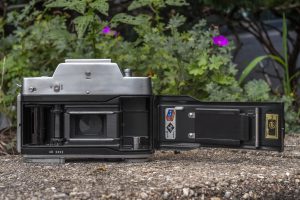
With the back of the camera open, we see the Flexilette’s film compartment. Although the door is right hinged, film transport is right to left onto a single slotted fixed take up spool. By the time the Flexilette would have hit the market, left to right film transport cameras and those with multi-slotted spools had become much more common.
A convenient feature is the use of fabric light seals instead of foam like later cameras would have had. The seals on this camera were still doing their job without needing to be replaced.
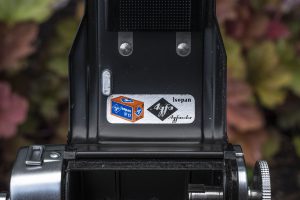
The film door has a unique looking pressure plate that’s smooth on the top and bottom, but has recessed divots in the middle where the film will actually pass. These divots, along with the metal roller to its right are both there to reduce resistance as film travels through the camera. Also note both the original AGFA film sticker and German language dealer sticker, likely showing where this particular camera was originally purchased.
The back of the top plate has both the exposure counter reset slider which is needed to properly set the counter to 36, 24, or 20 when loading in new film and a rewind release switch. There is also a small release latch in the top center for opening the viewfinder hood. Looking at the Flexilette from the back gives a really good view of how tall it is. Despite this having a fixed waist level viewfinder, there would have been enough room for an eye level pentaprism.
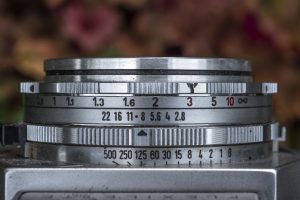
The large overall diameter of the lens ring is much bigger than the shutter itself, but AGFA cleverly designed the shutter controls around the outer ring. Looking down from the top of the camera, we see the focus ring in meters followed by the aperture and then shutter speed rings. I prefer this arrangement to other cameras, as this is the order from front to back of controls I use frequently to least frequently. When I shoot outdoors, I almost always set the shutter speed to a single speed and leave it there, controlling exposure with the iris so keeping the shutter speed ring closest to the body keeps it out of the way.
By far, my biggest complaint about the entire camera is in how narrow these rings all are. The shutter speed ring has two plastic grips on opposite ends of the ring allowing for easy reach, but the aperture selector is barely 3mm and the focus ring a hair thinner than that. This makes locating these rings quickly while composing your image somewhat of a challenge. While I appreciate the compactness of the lens and shutter in this camera, I wonder if a slightly longer snout would have made things a bit easier to use.
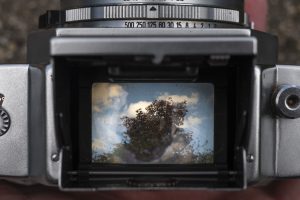
What separates the Flexilette from other SLRs is that is not an SLR at all, it is a true Twin Lens Reflex camera which works like any other 35mm or medium format TLR you’ve ever used. Since the viewfinder image comes through a separate lens from the one that captures the image, there is never any viewfinder blackout. This might not seem like a big deal until you actually use it, as the lack of any blackout is almost startling, but also the sound of the shutter firing is extremely quiet, and not at all like an SLR.
The viewfinder is not removable, but otherwise works like a waist level finder on a Nikon F, Miranda, or any other camera with the same feature. The focusing screen is not changeable, but doesn’t really need to be, as the frosted ground glass is very bright and shows little to no vignetting. Neither the Flexilette’s manual or the camera itself give any specs on the viewing lens, but that it is similar in size to the taking lens suggests it is also an f/2.8 lens, which is quite surprising considering how bright it makes the viewfinder.
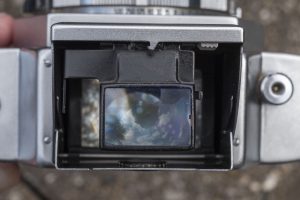
In the center of the focusing screen is a convenient split image focus aide that helps for precision focus. If more precision is needed, a fold down magnifying glass helps make fine focus even easier. When you need to use the magnifying glass, a small knurled slider in the upper right corner of the hood acts as a release latch. A quick slide to the left and the magnifying glass springs into position. This is a small detail that I really appreciated as some cameras make getting to the glass difficult, requiring you to shove your finger in there to pull it out.
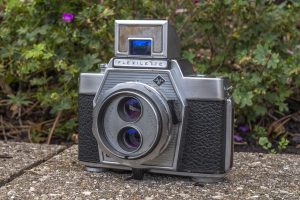
For fast action scenes where the reversed image from a waist level finder is not convenient, the Flexilette has a really nice optical sports finder. With the hood up and the magnifying glass out of the way, there is a direct view through a round hole on the back of the viewfinder hood, through the blue tinted rectangular glass window on the top of the hood. Compared to many medium format TLRs that simply have glass-less open holes in the hood, the one on the Flexilette does a better job of framing your shot to accurately show what will be captured on film.

While shooting the Flexilette, I found using the sports finder to be more enjoyable than the waist level finder, as the f/2.8 Apotar lens has pretty good depth of field for a lens of its type. In good outdoor lighting, with the diaphragm set to f/11 and the lens focused to 15 feet (~5 m) everything from about 9 to 46 feet will be in focus. If you can stop the lens down to f/22, depth of field expands from about 6.5 feet to infinity meaning that most fast action shots can be easily captured in bright light.
Overall, the Flexilette is a very interesting camera that can best be described as a TLR in a 35mm SLR body. Everything about the camera feels like an SLR, until you actually use the viewfinder. The lack of viewfinder blackout is a minor, but significant detail, and with the excellent implementation of the sports finder, allows the camera to be used very quickly.
As I always say in this section of a review, but what kinds of images does it make?
My Results
When I got the Flexilette, everything about the camera was stiff, the focus, the shutter, even opening the viewfinder required an extra bit of help to get it fully erect. I found that simply by repeatedly exercising the camera, things got better. The shutter still hung on any speed under 1/30 but that didn’t bother me as I rarely use speeds so slow anyway.
In normal instances when I have a non working shutter, I usually give it a flush, but after seeing that the camera seemed to be responding to my makeshift “camera yoga” I decided to wipe it down and shoot it as is. To be safe, I kept the shutter fixed at 1/125 which seems to be a pretty safe speed for most cameras with iffy shutters. To compliment that speed, I loaded in some bulk Kodak TMax 100 and hoped for the best.
Edit (11/4/20): After publishing this review, reader Lillian J alerted me to an article she wrote about the Flexilette on her site, which also includes some disassembly instructions that can be used if you want to try and remove the old sticky lube and replace it with something better. Check it out!
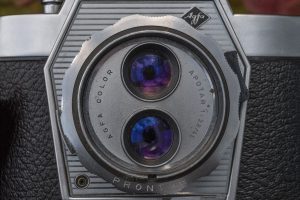
I could have lied to you in the section above and said that I sent this Flexilette off to any number of German camera repair specialists and had a full CLA, as the images I got from it look like they came from a perfectly working camera.
My use of a single 1/125 shutter speed and a 100 speed film that allowed for good use of the Sunny 16 rule produced an entire roll of perfectly exposed images. All of the original light seals in the door channels and the hinged area of the film compartment were still in tact and did a good job at keeping light leaks out. Like all leaf shutter cameras, there’s no risk of pinhole light leaks through a cracked or otherwise degraded cloth focal plane shutter.
Finally, the Color-Apotar f/2.8 lens, despite being “just” a 3-element design, was sharp and produced images every bit as nice as any triplet by Carl Zeiss, Leitz, or Nippon Kogaku might have, suggesting that at whatever discount there might have been with this camera compared to an AGFA SLR does not translate into poor images.
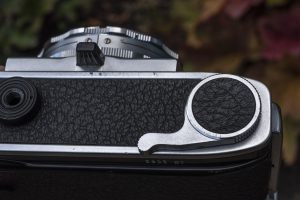
The Flexilette is a strange camera to shoot as each time I would pick it up, my brain required a short “oh yeah” moment to remember where the controls were. The viewfinder is nice and bright with a very easy to use split image focus aide in the center. I had no issues using the camera in all but the worst lighting conditions. For fast action shots, an optical sports finder is ever present, only requiring you to move the precision focus magnifying glass out of the way. The use of an optical finder, as opposed to a straight through hollow frame like on many medium format TLRs gives a more accurate estimate of the exposed area than simply looking through a hole.
The few complaints about the camera all fall into the category of nitpicks. I’ve never found cameras with bottom film advance levers to be any better or worse than those with top mounted levers, but the positioning of it on the left of the bottom is a bit weird. In use, it hardly caused a problem, but on occasion stumped me when I went to advance the film with my right thumb only to have to switch to the left.
The other nitpick is that in AGFA’s effort to make the front lens and shutter assembly as compact as possible, they went a bit too far in making both the aperture and shutter speed rings narrow. The shutter speed ring is closest to the camera’s body, but has opposing plastic clips around the perimeter making it easy to grip, however the aperture ring is just a large knurled ring that’s maybe 3mm thick. It is not impossible to change, but not something you’d want to do quickly.
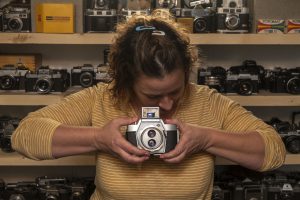
Otherwise, the ergonomics of the camera are quite good. The shutter release appears in a usual location on the right side of the top plate, but when held at waist or chest level is comfortably located in a position where your right thumb can easily access it with your other fingers free to grip the camera from the front and bottom. The Flexilette’s user manual suggests using your right index finger like a normal 35mm camera, but I found the method shown in the picture to the right to feel much more natural.
Firing the shutter is very quiet. Not only is there no noise from a moving reflex mirror, but the Prontor Leaf shutter is also very quiet. Pressing the shutter release only produces a faint click, like that of a leaf shutter rangefinder. The lack of any viewfinder blackout is also a plus as the image seen through the viewfinder is still there at the moment of exposure. Extremely quiet operation, along with the waist level finder means this camera could be ideal for discreet situations like street photography where you don’t want someone to know you are taking their picture.
The AGFA Flexilette is a strange looking and fun camera to use, even if it has some questionable ergonomic choices. Like most AGFA cameras, its lens produces wonderful shots that are as good as those shot on a huge number of other premium cameras.
I don’t know exactly what market segment AGFA was hoping to reach with this model, but it wasn’t in production for long, suggesting that market didn’t exist. Still, this is a cool camera that is worth checking out if you are able.
Related Posts You Might Enjoy
External Links
http://camera-wiki.org/wiki/Flexilette
http://www.rolandandcaroline.co.uk/flexilette.html
https://photojottings.com/agfa-reflex-flexilette-review/
https://www.35mmc.com/05/03/2019/agfa-flexilette-review/
http://lilianj.com/article16/agfa-flexilette
https://vintagecameralab.com/agfa-flexilette/
https://simonhawketts.co.uk/2019/10/20/agfa-flexilette-35mm-tlr-camera/
https://alexsavin.me/eng/posts/2016-07-14-agfa-flexilette-35mm-camera.html

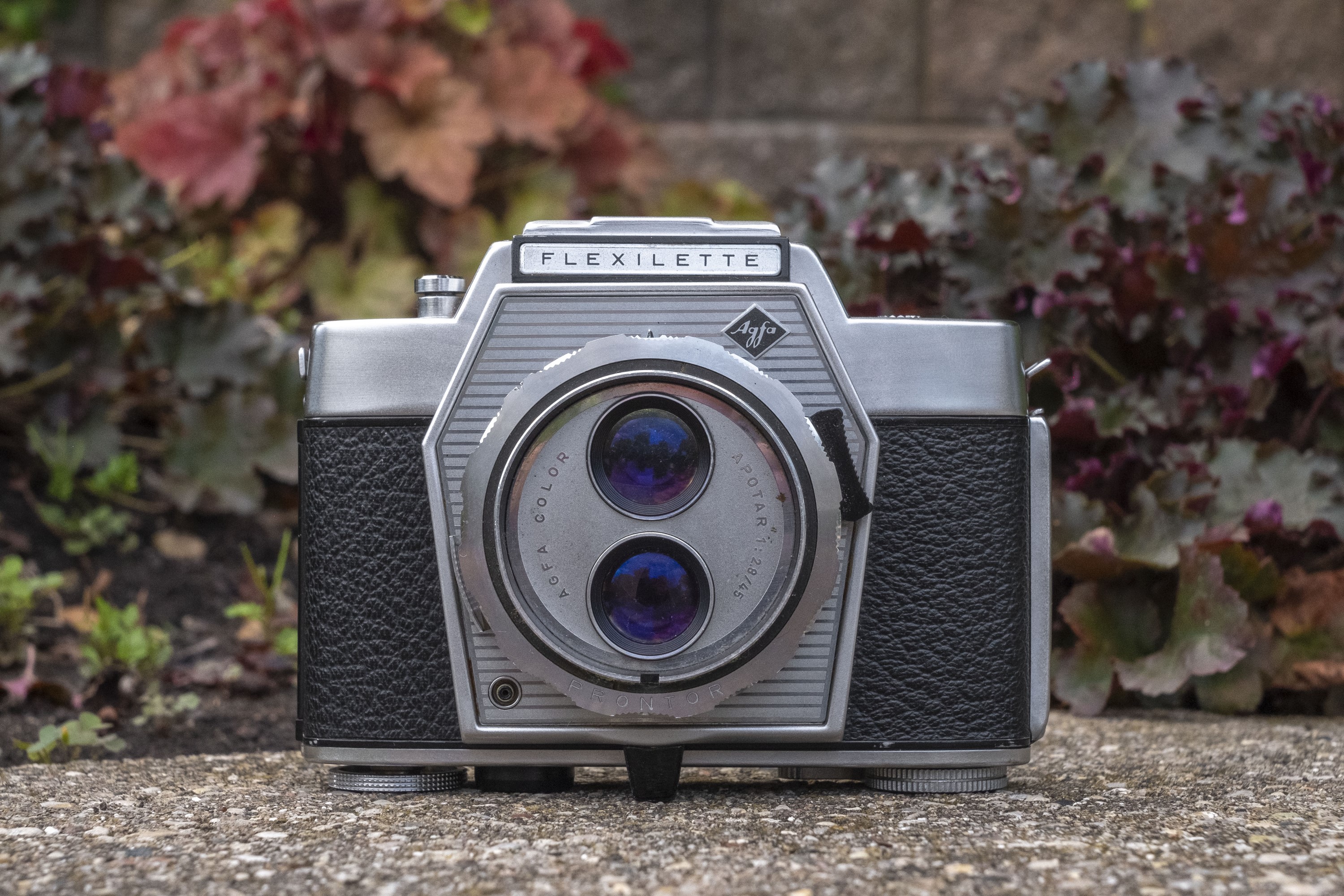
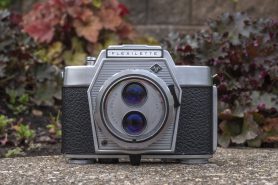
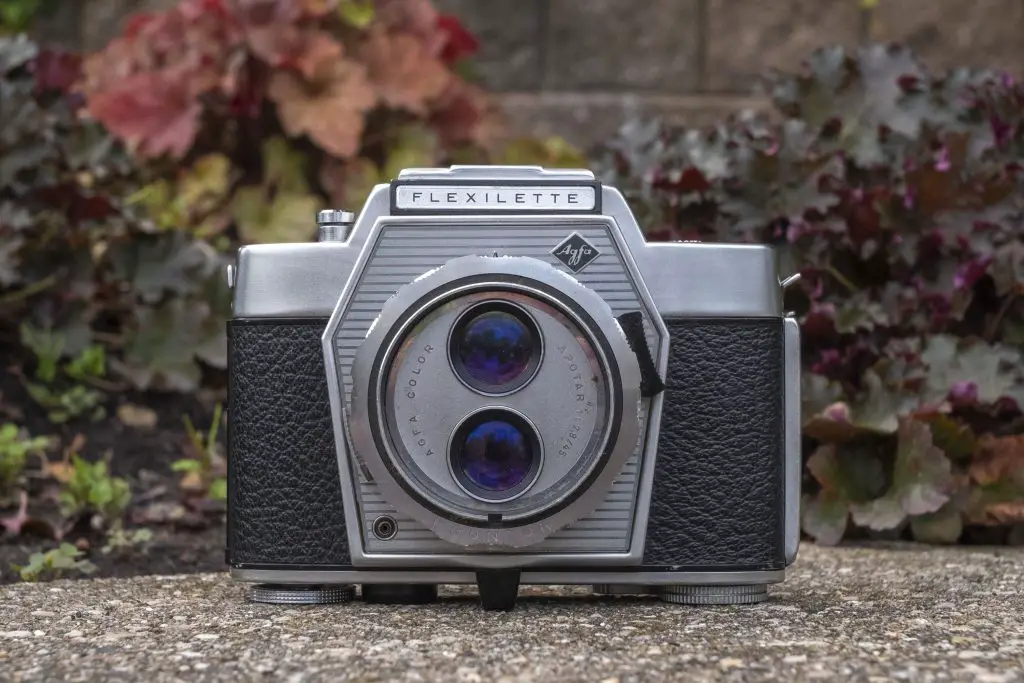















Agfa used a lubricant for focusing helicals that has not aged well at all. The stiff focus you described is common on Karats as well. The short-term cure is a tiny trickle of lighter fluid into the gap around the focusing ring, followed after a few minutes by several high-torque twists. This breaks up the ossified “green grease” Agfa used. But this treatment is short-term, as it leaves residue and can lead to a dry helical. One really needs to do a CLA if one is serious about shooting these old Agfa 35s!
You’re definitely right about that! I have taken apart several Karats and they all have that waxy, green stuff in there. The Karats are much easier to take apart though so after looking at this one, with it at least still being usable, and not totally confident I’d be successful, I shot it as is, but you’re right, to keep shooting it reliably, I’d definitely want to send it to someone and get it properly cleaned and lubed.
Mike, clearing the cobwebs of my memory, I always believed that the Color-Apotar was a triplet and doing a fare amount of searching on the net this seems to be confirmed. It would seem a little odd that Agfa would produce a 4 element lens at a cheaper price than its own Color-Solinar, which for quite some time reigned as their top lens. It seems that the Apotar is an improvement on the Agnar by making one of the elements from the new rare earth glasses that became available. This led many to believe that the Apotar was no more than a slightly redesigned Agnar.
From your images, it seems to work very well indeed in the near-field image of the toy digger, which is excellent, but with increasing focusing distances it seems to fall off more than expected. I wonder if the design was thus optimised for the 3 to 25ft range?
Terry, I could have swore that I read somewhere that it was a 4-element but now I can’t find where. It’s not mentioned in the manual or the German language pamphlet I found, so you’re probably right. This was a lower cost camera so a triplet definitely makes more sense. I have updated the review.
That is an impressively sharp lens on that strange looking camera. Nice shots.
I have the same one, except externals are less good than yours… and also had the green stuff problem… that i solved using an oven, without any of the lenses in place, of course !
And yes, i think so too, they’re triplets, as far as i remember.
You’ll find more photos and details here : http://lilianj.com/article16/agfa-flexilette
Wish i had more time to try it, but…
Lillian, thank you for the note and link to your site! I missed it when doing my research for the Flexilette. I updated the review both with a link to your article at the very bottom, but a short blurb right before My Results directing people to your site if they want to see some disassembly instructions!
Hi Mike, wow, such an honor ! Many thanks to you 🙂 Well, hope it could help someone to figure how to take that funny beast apart !
Nooo, another super-desirable camera that will succumb to the ‘Eckman Effect’ – if they were already expensive, Flexilettes will now skyrocket in price :/ I’m half-joking, of course. This was a great review, and it only solidified my desire for one of these odd ducks.
Regarding the lack of a Zeiss Ikon focal plane shutter SLR: as you mentioned, their ownership of Deckel and Gauthier had a lot to do with their refusal to abandon central shutters, but even more important was a lawsuit filed by Ernst Leitz against Zeiss Ikon, when the former learned that the latter were working on a focal plane shutter of their own. Postwar Germany was a weird place; as the heart of their optics and photography industry lay shattered and burnt (Dresden and its environs suffered the worst of the Allied bombing at the tail end of the war), all of their valuable patents were made free for all the world to use, as part of the war reparations imposed on the country. Even Japan, that was part of the Axis, got to exploit said patents (ironically).
However, the rule did not apply within Germany herself, and so Leitz could successfully sue and prevent Zeiss from making any cloth focal plane shutter thanks to their patents. This explains the horrid shutter design used in the Contarex, and why it took them so long to finally jump on board this train (Leitz’s patent had finally expired in the ‘60s).
Agfa probably stuck to central shutters because that’s what they knew. Unlike in Japan, where everybody and their mother was building focal plane devices, in Germany that was a much more expensive proposition. And, for a budget-minded company, any extra expense was probably anathema. That, and Leitz’s zeal to defend their own stuff explain Agfa’s devotion to such an obsolete type of tech.
One of these days, I should do a study on this “Eckman effect” and see if my reviews actually have a noticeable change in sale prices for cameras I review! I would have to probably do it discreetly on a number of cameras though before and after reviewing them as I’d need a good enough sample size to see if there is a difference.
I’m pretty sure that we’ve seen an uptick in the prices of Kowa SET R’s (which used to be dirt cheap before your review) as well as those of Pax and Leidolf cameras thanks to you. There are some models that I had been tracking before you reviewed them. In that same vein, do you plan to review a Zeiss Werra anytime soon? To know if I should hurry the hell up in completing my collection or not 😉
I forgot to add that the Pentinas seem to be immune to the Eckman Effect, though – prices have remained pretty stable. So, I guess it depends on how effusive you are in your review as to how much the prices jump? Or maybe not, as those Anscomarks are going for even crazier prices lately…